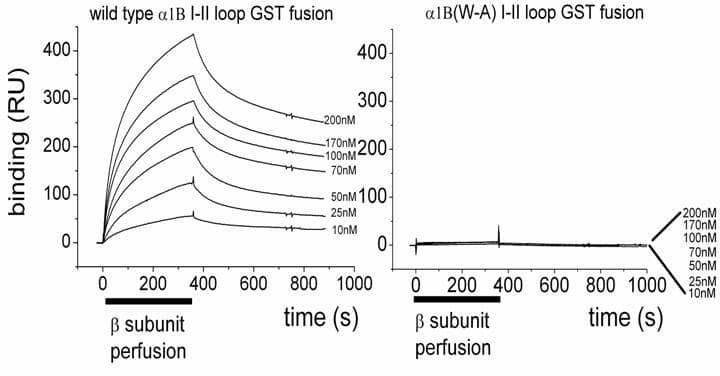High-voltage activated (HVA) calcium channels are heteromultimers composed of a main pore-forming CaVα1 subunit associated with auxiliary subunits β and α2δ. The β subunits modulate biophysical properties of the channels and promote the voltage-dependence of modulation of N-type calcium channels by G proteins (Meir et al. 2000). They bind to an interaction site of 18 amino-acids (QQxExxLxGYxxWIxxxE), the alpha-interaction domain (AID), conserved in the I-II loop of the CaVα1 subunit of all HVA calcium channels. By mutating W391 to A in the AID of CaV2.2, Biacore experiments confirmed that this amino-acid is essential for β1b subunit binding (Fig. 1), for plasma membrane expression and for modulation of the biophysical properties of CaV2.2 channels. Whereas robust currents with 10 mM barium as charge carrier were recorded using the patch-clamp technique on tsA-201 cells co-expressing CaV2.2 with β1b (−219.5±41 pA/pF at +20 mV ; mean±S.E.M., n=12), co-transfection of CaV2.2(W391A) with β1b induced small currents (−31.7±7.4 pA/pF at +20 mV ; n=11; p<0.01 using an unpaired Student's t test). Moreover, without ,β CaV2.2 produced small but recordable currents (−8.2±1.1 pA/pF at +20 mV ; n=13; p<0.01) while no currents were recorded when Ca2.2(W391A) was expressed alone (n=21), suggesting that some endogenous β may be present in tsA-201 cells and trafficking wild type CaV2.2. We then studied the G protein modulation of these channels by co-expressing a dopamine D2 receptor and activating it with the D2 receptor agonist quinpirole (100 nM). For the wild-type channel, quinpirole induced an inhibition of 53.5±3.8% (n=12; p<0.01) of the currents, a +7 mV shift of activation and prepulse potentiation was observed. The CaV2.2(W391A) mutant was still inhibited (46.4±8% n=11; p<0.01) by quinpirole and a positive shift of +6.5 mV for its activation still occurred but no prepulse potentiation was observed for this mutant. In contrast, only the expression of the channel at the plasma membrane was affected when CaVβ2a was co-expressed with this mutant channel, while all the biophysical properties of the expressed CaV2.2W391A channels were still normally modulated by the palmitoylated CaVβ2a including the voltage-dependence of G-protein modulation, suggesting another level of modulation by this subunit. These results confirm that the W391 is crucial for β subunit binding to the I-II linker of CaV2.2, and show that no CaV2.2 is functional at the plasma membrane in the complete absence of interaction with a β subunit. The results also provide evidence for the role of β subunits in the voltage-dependence of modulation of N-type calcium channels by G protein-coupled receptors.
University of Bristol (2005) J Physiol 567P, C90
Oral Communications: Crucial role of beta subunits for expression and G protein modulation of N-type calcium channels revealed by mutational analysis of the I-II loop of CaV2.2
Leroy, Jerome; Richards, Mark; Butcher, Adrian J; Nieto-Rostro, Manuela; Pratt, Wendy S; Davies, Tony; Dolphin, Annette C;
1. Pharmacology, University College London, London, United Kingdom.
View other abstracts by:
Figure 1: Examples of Biacore 2000 sensorgrams for comparison of purified beta1b binding to a GST- CaV2.2 I-II loop (A) GST- CaV2.2 (W391A) I-II loop (B).
Where applicable, experiments conform with Society ethical requirements.

